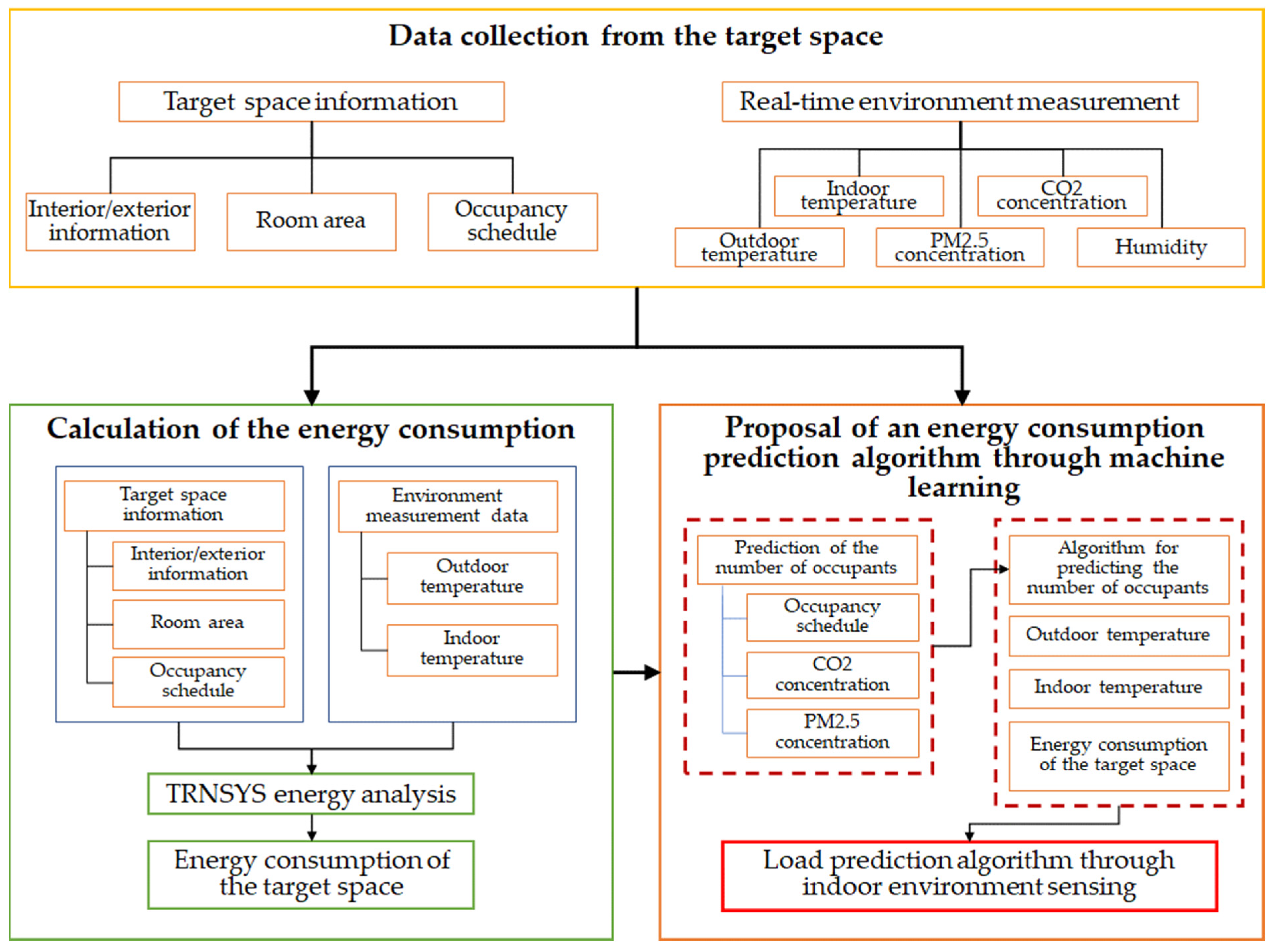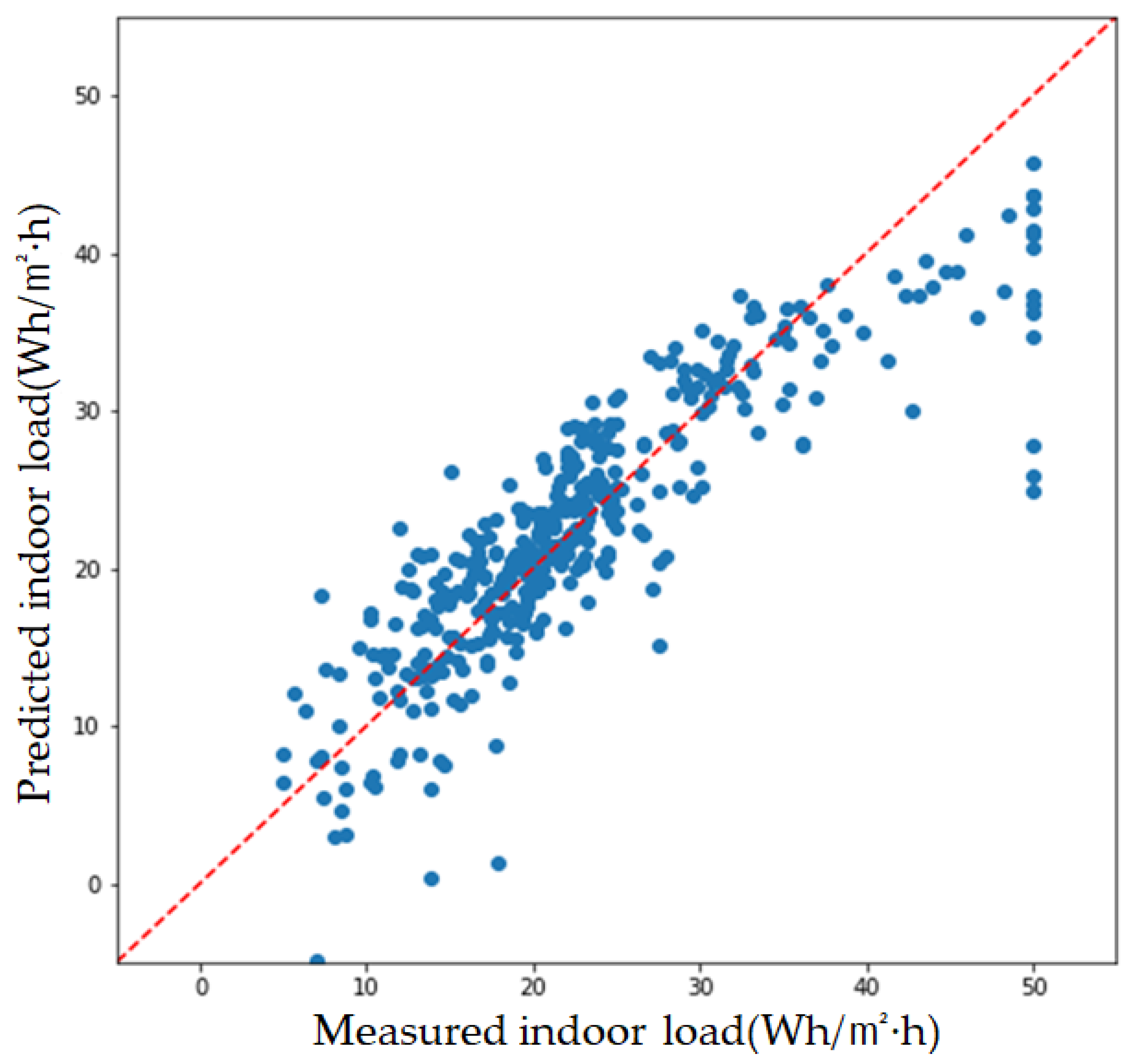Load Prediction Algorithm Applied with Indoor Environment Sensing in University Buildings
Abstract
1. Introduction
- A relatively simple and inexpensive sensor module, which can measure the indoor thermal environment and air environment, was produced and used in experiments so that load-prediction-related technology was not limited to some buildings.
- Buildings with high energy consumption and irregular energy use schedules, which have not commonly been looked at in previous studies, were selected as targets.
- Among the machine learning algorithms, the multiple linear regression algorithm was applied because it is simple and suitable for real-time prediction as it can rapidly process many variables.
- Quantitative assessment was performed by comparing the values predicted by the load prediction algorithm with the actual indoor load.
2. Indoor Environment Measurement and Analysis
2.1. Status of the Target Building
2.2. Comprehensive Indoor Environment Sensor Module
2.3. Verification of the Comprehensive Sensor Module
2.4. Measurement Method
3. Proposal of a Real-Time Load Prediction Method
Overview of a Real-Time Load Prediction Algorithm
4. Results and Discussion
4.1. Analysis of the Indoor Environment of the Target Building
4.2. Algorithm for Predicting the Number of Indoor Occupants
4.3. Derivation and Verification of the Algorithm for Predicting the Load in Real Time
5. Conclusions
- When the indoor environment of the measured space was analyzed using the CSM, the temperature, humidity, particulate matter (PM), and CO2 level changed according to variations in occupant numbers. When the significance of machine learning was tested for the prediction of occupant number, the regression coefficient and significance level of CO2 were calculated to be 24 and 0.002, respectively, indicating that the CO2 concentration is closely related to the occupant number.
- A load prediction algorithm was proposed by reflecting the algorithm for predicting the number of occupants according to the CO2 concentration. When the significance of each variable was tested, the regression coefficient and significance level of indoor temperature were calculated to be 31 and 0.001, respectively, excluding the CO2 concentration reflected in the occupant prediction algorithm and the number of occupants. This result indicates that the energy consumption prediction algorithm is closely related to the predicted number of occupants and indoor temperature.
Author Contributions
Funding
Conflicts of Interest
References
- Chu, W.; Vicidomini, M.; Calise, F.; Duić, N.; Østergaard, P.A.; Wang, Q.; da Graça Carvalho, M. Recent Advances in Technologies, Methods, and Economic Analysis for Sustainable Development of Energy, Water, and Environment Systems. Energies 2022, 15, 7129. [Google Scholar] [CrossRef]
- Ministry of Foreign Affairs of KOREA, The Republic of Korea’s Enhanced Update of its First Nationally Determined Contributionits. 2021. Available online: https://www.mofa.go.kr/www/brd/m_4080/view.do?seq=371966 (accessed on 23 December 2019).
- Ministry of Trade, Industry and Energy of KOREA, Industry and Energy (New Renewable Energy Policy Division). New Energy and Renewable Energy Development, Use, and Spread Promotion Law. 2005. Available online: https://www.law.go.kr/lsInfoP.do?lsiSeq=231683#0000 (accessed on 4 December 1987).
- Ministry of Land, Infrastructure and Transport of KOREA, Building Energy Certification Rules. 2017. Available online: https://www.law.go.kr/lsInfoP.do?lsiSeq=191338#0000 (accessed on 20 May 2013).
- KOREA Energy Agency, 2021 Energy Statistics Handbook. 2021. Available online: https://www.energy.or.kr/web/kem_ho-me_new/info/statistics/data/kem_list.asp (accessed on 3 August 2021).
- Ragab, K.M.; Orhan, M.F.; Saka, K.; Zurigat, Y. A Study and Assessment of the Status of Energy Efficiency and Conservation at School Buildings. Sustainability 2022, 14, 10625. [Google Scholar] [CrossRef]
- Mancini, F.; Nardecchia, F.; Groppi, D.; Ruperto, F.; Romeo, C. Indoor Environmental Quality Analysis for Optimizing Energy Consumptions Varying Air Ventilation Rates. Sustainability 2020, 12, 482. [Google Scholar] [CrossRef]
- Zinzi, M.; Pagliaro, F.; Agnoli, S.; Bisegna, F.; Iatauro, D. On the Built-Environment Quality in Nearly Zero-Energy Renovated Schools: Assessment and Impact of Passive Strategies. Energies 2021, 14, 2799. [Google Scholar] [CrossRef]
- Franco, A.; Bartoli, C.; Conti, P.; Miserocchi, L.; Testi, D. Multi-Objective Optimization of HVAC Operation for Balancing Energy Use and Occupant Comfort in Educational Buildings. Energies 2021, 14, 2847. [Google Scholar] [CrossRef]
- Simanic, B.; Nordquist, B.; Bagge, H.; Johansson, D. Influence of User-Related Parameters on Calculated Energy Use in Low-Energy School Buildings. Energies 2020, 13, 2985. [Google Scholar] [CrossRef]
- Kim, E.; Ha, Y. Vitalization Strategies for the Building Energy Management System (BEMS) Industry Ecosystem Based on AHP Analysis. Energies 2021, 14, 2559. [Google Scholar] [CrossRef]
- Hwang, J.S.; Rosyiana Fitri, I.; Kim, J.-S.; Song, H. Optimal ESS Scheduling for Peak Shaving of Building Energy Using Accuracy-Enhanced Load Forecast. Energies 2020, 13, 5633. [Google Scholar] [CrossRef]
- Cho, J.-K.; Moon, J.; Kang, H. Energy Performance Analysis for Energy Saving Potentials of a Hospital Building: A Case Study Methodology Based on Annual Energy Demand Profiles. Korean J. Air-Cond. Refrig. Eng. 2017, 29, 29–37. [Google Scholar] [CrossRef]
- Jeon, B.-K.; Kim, E.-J. White-Model Predictive Control for Balancing Energy Savings and Thermal Comfort. Energies 2022, 15, 2345. [Google Scholar] [CrossRef]
- Moayedi, H.; Mosavi, A. Double-Target Based Neural Networks in Predicting Energy Consumption in Residential Buildings. Energies 2021, 14, 1331. [Google Scholar] [CrossRef]
- Khan, A.-N.; Iqbal, N.; Rizwan, A.; Ahmad, R.; Kim, D.-H. An Ensemble Energy Consumption Forecasting Model Based on Spatial-Temporal Clustering Analysis in Residential Buildings. Energies 2021, 14, 3020. [Google Scholar] [CrossRef]
- Kumari, A.; Vekaria, D.; Gupta, R.; Tanwar, S. Redills: Deep Learning-Based Secure Data Analytic Framework for Smart Grid Systems. In Proceedings of the 2020 IEEE International Conference on Communications Workshops (ICC Workshops), Dublin, Ireland, 7–11 June 2020. [Google Scholar] [CrossRef]
- Ayub, N.; Irfan, M.; Awais, M.; Ali, U.; Ali, T.; Hamdi, M.; Alghamdi, A.; Muhammad, F. Big Data Analytics for Short and Medium-Term Electricity Load Forecasting Using an AI Techniques Ensembler. Energies 2020, 13, 5193. [Google Scholar] [CrossRef]
- Chekired, F.; Taabli, O.; Khellili, Z.M.; Tilmatine, A.; de Almeida, A.T.; Canale, L. Near-Zero-Energy Building Management Based on Arduino Microcontroller—On-Site Lighting Management Application. Energies 2022, 15, 9064. [Google Scholar] [CrossRef]
- Grygierek, K.; Ferdyn-Grygierek, J. Design of Ventilation Systems in a Single-Family House in Terms of Heating Demand and Indoor Environment Quality. Energies 2022, 15, 8456. [Google Scholar] [CrossRef]
- Aldekheel, M.; Altuwayjiri, A.; Tohidi, R.; Jalali Farahani, V.; Sioutas, C. The Role of Portable Air Purifiers and Effective Ventilation in Improving Indoor Air Quality in University Classrooms. Int. J. Environ. Res. Public Health 2022, 19, 14558. [Google Scholar] [CrossRef] [PubMed]
- Fan, G.; Chang, H.; Sang, C.; Chen, Y.; Ning, B.; Liu, C. Evaluating Indoor Carbon Dioxide Concentration and Ventilation Rate of Research Student Offices in Chinese Universities: A Case Study. Processes 2022, 10, 1434. [Google Scholar] [CrossRef]








| Category | Content |
|---|---|
| Structure | RC structure Steel frame structure |
| Building area | 1504.41 m2 |
| Total floor area | 1453.62 m2 |
| Window area ratio | 70% |
| Finishing | Concrete exposure/water-repellent coating 24 mm double glazing 0.5 mm wrinkle resin galvanized sheet |
| Device Name | Model Name | Measurement Range | Error Rate |
|---|---|---|---|
| Mainboard | Arduino UNO R3 | - | - |
| Temperature and humidity sensor | DHT22 | Temperature: −40~80 °C Humidity: 20~90% RH | Temperature: ±0.5 °C Humidity: ±2% RH |
| CO2 sensor | CM1107 | 0~5000 ppm | ±50 ppm + 3% |
| Particulate matter sensor | PM2008 | PM1.0: 0~1000 μg/m2 PM2.5: 0~1000 μg/m2 PM10: 0~1000 μg/m2 | PM1.0 & 2.5: 0~100 μg/m2: ±10 μg/m2 101~1000 μg/m2: ±10% PM10: 0~100 μg/m2: ±25 μg/m2 101~1000 μg/m2: ±25% |
| SKT100-X5 | TSI-9306 | |
|---|---|---|
| Measuring device |  |  |
| Measurement range |
|
|
| Flow rate | 0.5~1 L/min | 2.83 L/min |
| Resolution |
|
|
| Precision | ±3% | ±1% |
| CSM (A) | SKT100-X5 (B) | TSI-9306 (C) | Error Rate | |||||||||||
|---|---|---|---|---|---|---|---|---|---|---|---|---|---|---|
| First | Second | Third | Avg. | First | Second | Third | Avg. | First | Second | Third | Avg. | B/A | C/A | |
| PM2.5 | 12.7 | 13.1 | 13.8 | 13.2 | 15.2 | 15.7 | 16.0 | 15.6 | 14.3 | 15.0 | 15.2 | 14.8 | 18% | 12% |
| PM10 | 22.9 | 23.2 | 23.5 | 23.2 | 26.6 | 26.9 | 26.8 | 26.8 | 26.3 | 26.8 | 27.0 | 26.7 | 16% | 15% |
| CO2 | 228 | 230 | 223 | 227 | 241 | 239 | 235 | 238 | 5% | |||||
| Temperature | 25.3 | 25.6 | 26.0 | 25.6 | 25.6 | 25.5 | 25.9 | 25.7 | 0.3% | |||||
| Humidity | 55 | 51 | 52 | 52.7 | 56 | 51 | 53 | 53.3 | 1% | |||||
| Regression Coefficient (Coef) | Standard Deviation (Std Err) | Significance Level (p-Value > |t|) | |
|---|---|---|---|
| Temperature | 5.578 | 7.227 | 0.022 |
| Humidity | 1.508 | 1.013 | 0.004 |
| CO2 concentration | 24.074 | 5.844 | 0.002 |
| PM (PM2.5) | −6.135 | 4.211 | 0.425 |
| Measurement Space | Measurement Day 1 | Measurement Day 2 | Measurement Day 3 | |
|---|---|---|---|---|
| A | Average number of occupants | 3 | 3 | 3 |
| Energy consumption | 511 | 494 | 523 | |
| B | Average number of occupants | 1 | 2 | 2 |
| Energy consumption | 401 | 439 | 443 | |
| C | Average number of occupants | 20 | 25 | 25 |
| Energy consumption | 610 | 623 | 655 | |
| D | Average number of occupants | 17 | 18 | 15 |
| Energy consumption | 439 | 444 | 460 |
| Regression Coefficient (Coef) | Standard Deviation (Std Err) | Significance Level (p-Value > |t|) | ||
|---|---|---|---|---|
| Number of occupants (predicted) | 35.13 | 4.441 | 0.001 | |
| Outdoor | Temperature | 7.884 | 0.066 | 0.014 |
| Humidity | 5.006 | 0.057 | 0.009 | |
| CO2 concentration | 1.014 | 0.015 | 0.305 | |
| Indoor | Temperature | −31.077 | 5.541 | 0.001 |
| Humidity | −18.135 | 2.269 | 0.004 | |
| CO2 concentration | 29.002 | 3.944 | 0.001 | |
| Metric | Value |
|---|---|
| MSE | 23.063 |
| RMSD | 4.802 |
| MAE | 2.512 |
Disclaimer/Publisher’s Note: The statements, opinions and data contained in all publications are solely those of the individual author(s) and contributor(s) and not of MDPI and/or the editor(s). MDPI and/or the editor(s) disclaim responsibility for any injury to people or property resulting from any ideas, methods, instructions or products referred to in the content. |
© 2023 by the authors. Licensee MDPI, Basel, Switzerland. This article is an open access article distributed under the terms and conditions of the Creative Commons Attribution (CC BY) license (https://creativecommons.org/licenses/by/4.0/).
Share and Cite
Kim, Y.; Park, Y.; Seo, H.; Hwang, J. Load Prediction Algorithm Applied with Indoor Environment Sensing in University Buildings. Energies 2023, 16, 999. https://doi.org/10.3390/en16020999
Kim Y, Park Y, Seo H, Hwang J. Load Prediction Algorithm Applied with Indoor Environment Sensing in University Buildings. Energies. 2023; 16(2):999. https://doi.org/10.3390/en16020999
Chicago/Turabian StyleKim, Yunho, Yunha Park, Hyuncheol Seo, and Jungha Hwang. 2023. "Load Prediction Algorithm Applied with Indoor Environment Sensing in University Buildings" Energies 16, no. 2: 999. https://doi.org/10.3390/en16020999
APA StyleKim, Y., Park, Y., Seo, H., & Hwang, J. (2023). Load Prediction Algorithm Applied with Indoor Environment Sensing in University Buildings. Energies, 16(2), 999. https://doi.org/10.3390/en16020999







